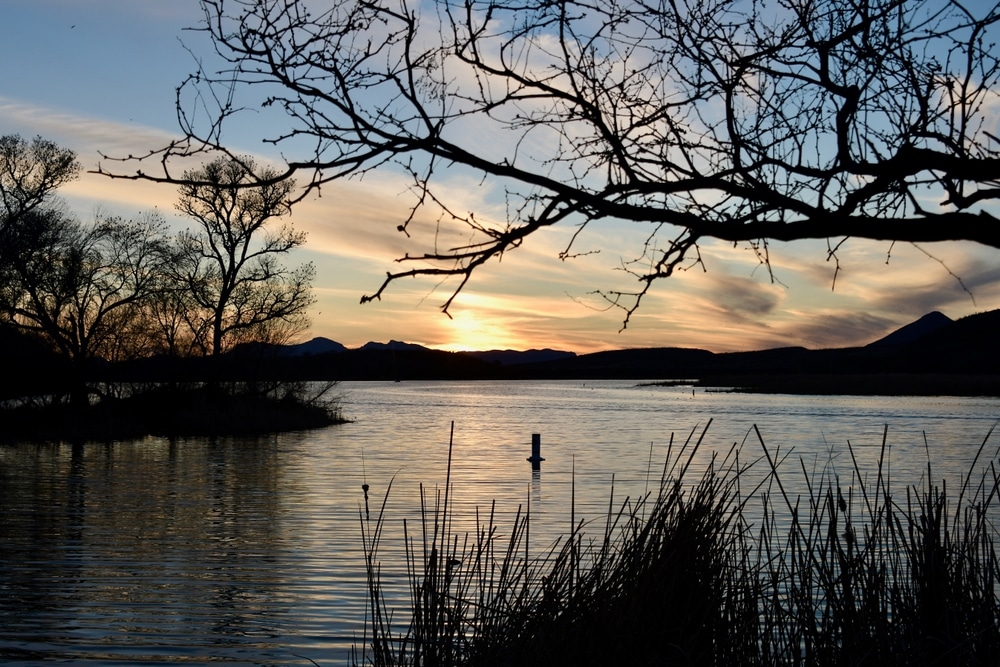Tucked away in the rolling hills of southeastern Arizona lies one of the state’s hidden treasures – Patagonia Lake State Park. Established in 1975, this serene oasis has been delighting visitors for nearly five decades with its pristine waters, diverse wildlife, and recreational opportunities. Located approximately 7 miles south of the charming town of Patagonia and about 18 miles northeast of Nogales, the park sits at an elevation of approximately 4,000 feet, offering visitors a refreshing escape from Arizona’s desert heat.
Patagonia Lake itself is a human-made reservoir, created by damming Sonoita Creek in the late 1960s. The 2.5-mile-long, 250-acre lake has become a beloved destination for water enthusiasts, anglers, campers, and nature lovers alike. As one of Southern Arizona’s most popular recreation spots, the park offers a stark contrast to the typical desert imagery associated with Arizona. Here, visitors can experience lush riparian areas, rolling grasslands, and a thriving aquatic ecosystem.

The park holds significant importance in Arizona’s state park system as one of the few locations offering extensive water recreation in the southern portion of the state. It represents Arizona’s commitment to preserving diverse landscapes and providing accessible outdoor recreation for all. In 2025, Patagonia Lake State Park will celebrate its 50th anniversary, marking half a century of conservation and public enjoyment.
Key highlights of the park include excellent fishing opportunities, with the lake stocked regularly with rainbow trout during winter months; abundant wildlife viewing opportunities including whitetail deer, great blue herons, and over 300 bird species; diverse water activities from swimming to boating; and interconnected hiking trails that lead into the adjacent Sonoita Creek State Natural Area. Whether you’re looking for a peaceful retreat or an adventure-filled getaway, Patagonia Lake State Park offers something for everyone in a stunningly beautiful setting that captures the diverse ecological essence of southeastern Arizona.

A designated swimming beach offers a sandy shoreline with gradual entry, making it ideal for families with children. This protected area includes nearby restroom facilities, picnic tables, and shade ramadas for comfortable day use. The relatively warm water temperatures during summer months make swimming particularly enjoyable, while the scenic surroundings create a dramatic backdrop for beach activities.

Patagonia Lake offers 265 acres of accessible water surface perfect for various watercraft. The lake accommodates motorboats, sailboats, canoes, and kayaks, with a 10 horsepower limit ensuring peaceful conditions. The marina provides boat rentals including pontoons, rowboats, and paddleboats for those without their own vessels. The lake’s unique canyon setting with tree-lined shores creates a scenic backdrop for leisurely cruising through protected coves and open water areas.

The lake is renowned for its excellent fishing opportunities year-round. Anglers can target rainbow trout (stocked during cooler months), largemouth bass, bluegill, catfish, and crappie. Numerous fishing docks and shoreline access points accommodate bank fishing, while boat fishing allows access to deeper channels and coves. The marina offers fishing supplies, bait, and local fishing information. Night fishing is permitted in designated areas, offering unique opportunities for catfish and bass.

Several trails wind through the park and adjacent natural areas. The Sonoita Creek Trail connects to the Sonoita Creek Natural Area with over 20 miles of pathways showcasing riparian habitats, oak woodlands, and mesquite bosques. The Overlook Trail provides panoramic vistas of the entire lake basin and distant mountains. These trails offer opportunities to observe native plants, geological features, and wildlife in their natural settings.
Located away from major urban light pollution, Patagonia Lake offers excellent conditions for stargazing. The dark skies and clear air create ideal conditions for viewing stars, planets, and celestial events. The open areas near the lakeshore provide unobstructed views of the night sky, while the higher elevation offers clearer atmospheric conditions than many desert locations.

The park is recognized as a premier birding destination with over 300 species documented in the lake and adjacent Sonoita Creek areas. Rare specialties include the northern beardless-tyrannulet, violet-crowned hummingbird, and thick-billed kingbird. The Lakeside Trail and creek access points provide excellent birding opportunities. The diverse habitats support both resident species and numerous migrants during spring and fall seasons, attracting birders from across the country.

Patagonia Lake features 105 developed campsites accommodating tents and RVs, with many sites offering direct lake views. Each site includes a fire ring, picnic table, and parking area, with modern restrooms and hot showers nearby. For those seeking alternative accommodations, the park offers boat-in camping sites accessible only by water and seven camping cabins with basic amenities. The lakeside camping experience is enhanced by spectacular starry skies and the sounds of nature.

Multiple day-use areas around the lake offer picnic tables, grills, and shade ramadas with scenic water views. These facilities are strategically placed to take advantage of shoreline vistas while providing comfort in the often sunny environment. Group picnic areas with larger capacity are available by reservation for family gatherings and special events.

| Detail | Information |
|---|---|
| Location | Patagonia, Arizona (southern Arizona) |
| Established | 1975 |
| Size | 2,658 acres (lake: 265 acres) |
| Elevation | 3,750 feet |
| Lake Origin | Man-made reservoir created by damming Sonoita Creek |
| Water Features | 2.5-mile long lake, average depth of 40 feet |
| Activities | Boating, fishing, swimming, camping, hiking, bird watching, picnicking |
| Fish Species | Bass, bluegill, catfish, crappie, rainbow trout (stocked) |
| Camping Options | 105 developed campsites, 12 boat-in sites, 7 cabins |
| Notable Trails | Sonoita Creek Trail, Overlook Trail |
| Birding | Over 300 species of birds recorded in the area |
| Wildlife | White-tailed deer, javelina, coatimundi, bobcat, various reptiles |
| Boating | No wake zones, boat rentals available (canoes, kayaks, pontoons, rowboats) |
| Swimming | Designated beach area |
| Seasonal Notes | Popular year-round; can be crowded on summer weekends |
| Amenities | Marina, boat ramp, store, showers, picnic areas, dump station |
| Nearby | Sonoita Creek State Natural Area (adjacent to the park) |
Patagonia Lake is a 250-265 acre man-made reservoir created by damming Sonoita Creek. Stretching approximately 2.5 miles in length, the lake provides a serene aquatic environment in the otherwise arid landscape of southeastern Arizona. With an average depth that allows for various water activities while maintaining healthy aquatic ecosystems, the lake has approximately 7 miles of shoreline, offering ample space for fishing, wildlife observation, and shoreline recreation.
The lake was created in the late 1960s when the Lake Patagonia Recreation Association constructed a dam across Sonoita Creek. What began as a private recreational development soon grew beyond the association’s capacity to manage due to its immense popularity. By the early 1970s, it became clear that the area would benefit from state management, and in 1975, Patagonia Lake officially became an Arizona State Park.
The dam itself stands as an engineering achievement that transformed the landscape, creating a permanent water source that now supports diverse ecosystems and recreational opportunities. While not as massive as some of Arizona’s larger dams, the Patagonia Lake dam effectively controls water flow along Sonoita Creek, helping to manage flash floods while maintaining consistent water levels for recreation and wildlife.
The park is nestled within the rolling hills of southeastern Arizona at an elevation of approximately 4,000 feet. This transitional zone between desert lowlands and mountain forests creates a unique landscape characterized by gentle, grass-covered hills dotted with mesquite, oak, and juniper trees. The setting provides a refreshing contrast to the saguaro-dominated landscapes typically associated with Arizona.
The terrain surrounding Patagonia Lake represents a portion of the “Sky Islands” region of Arizona, where isolated mountain ranges rise dramatically from lowland deserts, creating islands of distinct habitat and biodiversity. This geographic feature contributes to the area’s remarkable ecological diversity and scenic beauty.
The geological foundation of Patagonia Lake State Park consists primarily of sedimentary and volcanic rocks that tell the story of millions of years of geological activity. The lake basin itself sits within a valley formed through ancient tectonic processes that shaped much of southeastern Arizona’s distinctive landscape.
The hills surrounding the lake feature exposed rock formations that hint at the area’s volcanic past, with some outcroppings providing excellent viewpoints over the lake and surrounding countryside. These geological features not only create scenic vistas but also influence the local hydrology and plant communities.
Patagonia Lake is part of the Sonoita Creek watershed, which itself belongs to the larger Santa Cruz River basin. Sonoita Creek, the main tributary feeding the lake, continues downstream of the dam through the Sonoita Creek State Natural Area, supporting one of Arizona’s few year-round flowing streams.
The watershed collects runoff from the surrounding Patagonia Mountains and the San Rafael Valley, channeling seasonal rainfall into the creek system and ultimately into Patagonia Lake. This constant replenishment helps maintain water levels despite the region’s arid climate.
The health of this watershed is crucial not only for the recreational value of Patagonia Lake but also for the riparian ecosystems downstream. Conservation efforts focus on protecting water quality, managing erosion, and preserving natural water flow patterns to ensure the long-term sustainability of this vital resource in an increasingly water-challenged region.
Patagonia Lake State Park showcases an impressive diversity of plant life that reflects its position at the intersection of several ecological zones. Along the shoreline, visitors can observe lush riparian vegetation including cottonwoods, willows, and sycamores that provide critical shade and habitat. These water-loving trees create a stark contrast to the mesquite, acacia, and various cacti species that populate the drier upland areas surrounding the lake.
The park also features a variety of grasses native to the Sky Islands region of southeastern Arizona, including various grama species that wave in the gentle breezes across the rolling hills. Seasonal wildflowers bring splashes of color to the landscape, particularly after the summer monsoon rains, when Mexican goldpoppies, lupines, and penstemons transform the hillsides.
In the transitional areas between riparian and upland zones, visitors might spot Arizona sycamores, velvet ash, and oak trees that provide important mast crops for wildlife. The diversity of plant communities within the relatively small area of the park demonstrates the ecological richness that makes this region so special.
Patagonia Lake State Park is renowned for its wildlife viewing opportunities, offering visitors chances to observe animals in their natural habitat throughout the year. The park is particularly known for its population of Coues whitetail deer, which can often be spotted in the early morning or evening hours grazing on hillsides or coming down to the lake to drink. Lucky visitors might also catch glimpses of javelina, bobcats, or even the occasional coatimundi—a raccoon relative with a distinctive long tail that travels in family groups.
The lake environment supports numerous aquatic and semi-aquatic species, including beavers, muskrats, and various amphibians. Reptiles such as desert spiny lizards and several snake species also make their home in the park, adding to the biodiversity that makes this area so ecologically important.
For the best wildlife viewing experiences, park rangers recommend early morning or late afternoon visits when animals are most active. The creek trail offers excellent opportunities for wildlife spotting, as many animals come to the water source throughout the day. Visitors should remember to maintain a respectful distance from wildlife and never feed wild animals.
Patagonia Lake State Park has earned an international reputation as a premier birding destination, drawing ornithology enthusiasts from around the world. The park and adjacent Sonoita Creek State Natural Area boast records of over 300 bird species, including rare and unusual sightings that make this location a must-visit for serious birders.
Year-round resident birds include the vermilion flycatcher, with its brilliant red plumage; the canyon towhee; Inca dove; and several species of hummingbirds. The great blue heron is frequently spotted stalking the shoreline, while black vultures soar overhead. During migration seasons, the diversity explodes as neotropical migrants use the lake and creek as stopover points.
The park offers regular guided bird walks from November through April, led by knowledgeable rangers who help visitors identify species and learn about their habits and habitats. The Overlook Trail and Sonoita Creek Trail are particularly productive for birding, offering access to different habitat types within a relatively short distance.
The ecologically diverse environment of Patagonia Lake and Sonoita Creek supports several rare and threatened species. The creek is one of the few locations where the endangered Gila topminnow fish can still be found, making conservation of this watershed crucial for the species’ survival.
The area also provides important habitat for the Western yellow-billed cuckoo and the Northern Mexican gartersnake, both listed as threatened under the Endangered Species Act. The creek corridor is known to support nesting black hawks, a rare raptor species with limited range in the United States.
These special status species highlight the ecological importance of Patagonia Lake and underscore the park’s role in conservation efforts. Park management works closely with wildlife agencies to monitor populations and implement protective measures where needed.
Patagonia Lake State Park experiences distinct seasonal changes that transform the landscape and influence wildlife behavior throughout the year:
Spring brings mild temperatures and blooming wildflowers, particularly after wet winters. This season also marks the beginning of migratory bird arrivals and increased activity among resident wildlife.
Summer monsoons (typically July through September) bring dramatic afternoon thunderstorms that rejuvenate the landscape. The rainfall triggers new plant growth and fills ephemeral streams, creating additional water sources for wildlife. Water temperatures rise during this season, making the lake popular for swimming and water recreation.
Fall brings cooler temperatures and subtle color changes as deciduous trees like cottonwoods and sycamores begin to turn. This season marks the transition to winter fishing as the Arizona Game and Fish Department begins stocking rainbow trout in October.
Winter offers mild daytime temperatures compared to much of the country, though nights can be chilly. The cooler season brings different bird species to the area and changes the patterns of wildlife activity.
Each season offers unique ecological observations and recreational opportunities, making Patagonia Lake State Park a year-round destination for nature enthusiasts.
Patagonia Lake offers a refreshing aquatic playground for visitors seeking relief from Arizona’s heat. Swimming is permitted throughout most of the lake, with a designated swimming area at Boulder Beach near the marina providing a family-friendly environment. While there are no lifeguards on duty, the swimming area is marked with buoys and features a sandy beach perfect for relaxing between dips in the water.
Boating is one of the park’s most popular activities, with both motorized and non-motorized vessels permitted on the lake. The western portion of the lake allows motorized boats, while the eastern section is designated as a no-wake zone to preserve tranquility for anglers and wildlife. Two boat ramps provide easy access for visitors bringing their own watercraft.
For those without their own equipment, the Lakeside Market and marina offer rentals of various watercraft, including:
These rentals make water recreation accessible to all visitors and provide excellent ways to explore the lake’s coves and shoreline. The marina can be contacted at (520) 287-2804 for current rental rates and availability.
Patagonia Lake has earned a reputation as one of southern Arizona’s premier fishing destinations, offering year-round angling opportunities for multiple species. The lake sustains healthy populations of:
Additionally, the Arizona Game and Fish Department stocks the lake with rainbow trout every three weeks from October through March, creating exciting seasonal fishing opportunities.
The most productive fishing spots include:
Shore fishing is productive along much of the accessible shoreline, while boat anglers can reach more remote areas of the lake. Early mornings and evenings typically yield the best results, though seasonal patterns vary by species.
All anglers aged 10 and older must possess a valid Arizona fishing license, which can be purchased at the Lakeside Market within the park or online through the Arizona Game and Fish Department. State fishing regulations apply, including bag limits and size restrictions for certain species. Notably, there is a fish consumption advisory for flathead catfish due to elevated mercury levels—adults should limit consumption to 2.5 ounces per week, while children under 12 should limit consumption to 2 ounces per month.
Patagonia Lake State Park offers several hiking opportunities that showcase the natural beauty of southeastern Arizona:
Sonoita Creek Trail: The most accessible trail follows the creek bed for approximately half a mile from the eastern end of the park. This relatively flat trail offers excellent birding opportunities and connects to the more extensive trail system of the adjacent Sonoita Creek State Natural Area.
Overlook Trail: For those seeking more challenging terrain and spectacular views, this 1.5-mile loop trail offers a moderate hike with approximately 300 feet of elevation gain. It rewards hikers with 360-degree panoramic views of Patagonia Lake, the surrounding mountains, and the rolling grasslands typical of the region. The trail is particularly stunning during sunrise or sunset when soft light bathes the landscape.
Sonoita Creek State Natural Area Trails: Within the neighboring Sonoita Creek State Natural Area, more extensive hiking options become available, including the 6.5-mile Sonoita Creek Trail system that follows the riparian corridor. These trails vary in difficulty from easy to moderate and offer excellent opportunities for wildlife viewing and nature photography.
Trail conditions are generally best during the cooler months from October through April. Summer hikers should start early in the morning to avoid midday heat and bring plenty of water. All trails are well-marked, though hikers should obtain a trail map from the visitor center before setting out, particularly for the longer routes into the natural area.
Patagonia Lake State Park offers photographers countless opportunities to capture stunning landscapes, wildlife, and botanical subjects. The most iconic views include:
Wildlife photographers will find abundant subjects throughout the park. The creek trail offers excellent opportunities for bird photography, particularly during migration seasons. Patient photographers may capture images of deer coming to drink at dawn or dusk, while macro photographers can focus on butterflies, wildflowers, and other small subjects that showcase the area’s biodiversity.
For the best light, photographers should plan morning sessions from the east side of the lake and evening sessions from the west side or elevated viewpoints. The quality of light during the “golden hours” around sunrise and sunset transforms the landscape, creating warm tones that enhance the natural beauty of the park. Seasonal variations—spring wildflowers, summer storms, fall colors, and winter clarity—offer photographers different creative possibilities throughout the year.
With minimal light pollution compared to urban areas, Patagonia Lake State Park offers excellent opportunities for stargazing and night sky photography. The park’s location in southeastern Arizona—a region known for clear air and dark skies—makes it ideal for observing celestial objects, particularly during new moon periods when starlight is not competed with by moonlight.
The best stargazing locations within the park include open areas away from campground lights, such as the boat ramp parking areas after hours or designated day-use areas. The Overlook Trail viewpoint also provides an elevated position with expansive sky views, though night hiking requires appropriate preparation and care.
Visitors interested in stargazing should bring red-filtered flashlights to preserve night vision while navigating, plus warm clothing as temperatures can drop significantly after sunset, even during summer months. Binoculars or telescopes enhance the experience but aren’t necessary to appreciate the brilliant display of stars, planets, and the Milky Way that stretches across the dark sky on clear nights.
The park occasionally hosts night sky programs led by rangers or local astronomy groups, particularly during meteor shower events. Visitors should check the event calendar or inquire at the visitor center about upcoming astronomy programs during their stay.
Patagonia Lake State Park features 105 developed campsites that wind along the southern shore of the lake, offering beautiful views and easy access to recreation areas. Each campsite comes equipped with a picnic table, fire ring/grill, and parking for two vehicles, with select sites also featuring shade ramadas. Most sites accommodate both tent camping and RVs, with varying lengths that can fit most recreational vehicles and trailers.
The campground offers both electric and non-electric options:
Campground amenities include clean restroom facilities with flush toilets and hot showers, making extended stays comfortable. A dump station is available for RV campers, though it’s occasionally closed for maintenance. The campground is arranged in loops, with sites spaced to provide reasonable privacy while maintaining the community atmosphere typical of state park campgrounds.
Quiet hours are enforced from 9 p.m. to 8 a.m., with no generators, music, or loud voices permitted during these times. This policy ensures a peaceful experience for all campers and minimizes disruption to wildlife. The campground is particularly popular from May through November, with sites often filling up during evenings and weekends, making reservations highly recommended during these peak periods.
For those seeking a more secluded camping experience, Patagonia Lake offers 12 boat-in campsites accessible only by water. These primitive sites are scattered along the northern shoreline of the lake, providing privacy and a closer connection to nature than the developed campground.
Each boat-in site features a picnic table and fire ring, with some sites also equipped with portable restrooms. These sites do not have water or electrical hookups, so campers must bring all necessary supplies, including drinking water. The boat-in sites offer an excellent opportunity to experience the tranquility of the lake while still having basic amenities available.
Boats can be rented from the Patagonia Marina and Boat Rental located in the boat trailer parking lot if visitors don’t have their own watercraft. Reservations for boat-in sites can be made online through the Arizona State Parks reservation system, just like the developed campsites. Quiet hours (9 p.m. to 8 a.m.) apply to these sites as well.
For visitors seeking more comfort than traditional camping offers, Patagonia Lake State Park provides seven camping cabins that overlook the lake. These cabins offer a “glamping” experience with basic amenities while still allowing guests to immerse themselves in the natural environment.
The cabins vary slightly in configuration, but all include:
The cabins do not have running water, kitchen facilities, or bathrooms inside; guests use the campground’s central restroom and shower facilities. Some cabins are designated as pet-friendly, while others maintain a no-pets policy to accommodate visitors with allergies.
These popular accommodations often book well in advance, particularly during peak seasons and holidays. Reservations can be made up to one year ahead through the Arizona State Parks reservation system.
Campsite, cabin, and boat-in site reservations can be made through the Arizona State Parks reservation system, either online at AZStateParks.com or by calling the reservation desk at (877) MY-PARKS (697-2757). Reservation agents are available seven days a week from 8 a.m. to 5 p.m. Arizona time to assist with bookings and answer questions.
Reservations can be made up to one year in advance, which is recommended for popular weekends, holidays, and the peak season from October through April when the mild winter climate attracts visitors from colder regions. A credit card is required to secure reservations, with payment collected at the time of booking.
The cancellation policy allows for full refunds (minus a $5 processing fee) if cancelled at least 14 days before the scheduled arrival. Cancellations made 1-13 days before arrival receive a partial refund of the camping fees minus one night’s stay and the $5 processing fee. No refunds are issued for cancellations on the day of arrival or for no-shows.
For visitors who prefer hotel accommodations or when the park’s camping facilities are fully booked, several lodging options exist in the surrounding area:
Patagonia (7 miles north): The nearest options include bed and breakfast establishments like the Duquesne House Inn and the Stage Stop Inn, both offering comfortable rooms with local character and charm.
Nogales (18 miles south): Offers additional hotel options including national chain hotels and locally owned motels. These provide a convenient base for day trips to the park while offering full amenities and proximity to restaurants and shopping.
Sonoita and Elgin (approximately 30 minutes from the park): Offer unique stays at vineyards and ranches. These provide an excellent complement to a Patagonia Lake visit, allowing travelers to experience multiple aspects of southeastern Arizona’s diverse attractions.
To ensure an enjoyable experience for all visitors, Patagonia Lake State Park enforces several camping regulations:
For a comfortable camping experience, visitors should:
Patagonia Lake State Park is open year-round, with the entrance gate operating from 4 a.m. to 10 p.m. daily. The Visitor Center/Ranger Station has seasonal hours:
Visitors should be aware that the park occasionally implements temporary mid-day closures during peak periods due to reaching visitor capacity. This is most common on summer weekends and holidays when the day-use areas and parking lots fill up. To avoid disappointment, arrive early in the morning or call ahead to check current conditions.
Each season offers different experiences at Patagonia Lake:
Current entrance fees for Patagonia Lake State Park are $15-$20 per vehicle with 1-4 adults, depending on the season (higher rates apply during peak periods). Individual entrance fee (for pedestrians or bicyclists) is $3 per person. These day-use fees provide access to all park facilities including beaches, boat ramps, picnic areas, and trails.
For frequent visitors, the Arizona State Parks Annual Pass offers significant savings:
Veterans with a service-connected disability of 50% or greater can receive a free Military Access Pass, which provides day-use access to all Arizona State Parks. Active duty military personnel stationed in Arizona can also receive discounted annual passes.
All entrance and camping fees directly support park operations and improvements, as Arizona State Parks does not receive General Fund monies from the state tax system.
The ideal time to visit Patagonia Lake State Park depends largely on your preferred activities and tolerance for different weather conditions:
For water recreation enthusiasts, late spring through early fall offers the warmest water temperatures and longest daylight hours. May and September provide an excellent balance of comfortable temperatures and relatively fewer crowds compared to the peak summer months.
For anglers targeting trout, the optimal time is October through March when the lake is regularly stocked. Bass fishing tends to be best during spring and fall, particularly during early mornings and evenings.
Birding enthusiasts often prefer the migration seasons of April-May and August-September when diversity is highest. Winter months (December-February) bring different bird species and generally good viewing conditions.
To avoid crowds, weekday visits are recommended year-round, as weekends can be busy regardless of season. Early mornings offer the best wildlife viewing opportunities, greatest likelihood of calm waters for boating and fishing, and more comfortable temperatures during warmer months.
Patagonia Lake State Park enjoys a mild climate compared to many parts of Arizona:
Summer: Temperatures typically range from lows around 65°F to highs in the 90s°F, occasionally reaching 100°F in June before monsoon rains moderate the heat. The summer monsoon season (July-September) brings afternoon thunderstorms that can develop quickly, creating potential hazards for boaters and hikers. These storms typically pass quickly but can produce intense rainfall, lightning, and strong winds.
Winter: Features daytime highs typically in the 60s°F to low 70s°F, with nighttime temperatures occasionally dropping below freezing. Frost is possible from November through March, and while snow is rare, it does occur occasionally at this elevation.
Spring and Fall: Are transitional seasons with generally pleasant conditions. Spring can bring windy days, particularly in March and April, which may affect boating conditions. Fall typically features stable, mild weather with decreasing chance of afternoon storms as the season progresses.
Throughout the year, the sun’s intensity at this elevation can be deceptive, making sunscreen, hats, and adequate hydration essential even on seemingly mild days.
Patagonia Lake State Park strives to provide access for visitors of all abilities. The park features several ADA-accessible facilities, including:
Several campsites are designed to accommodate visitors with disabilities, featuring level, paved pads and proximity to accessible restroom facilities. These sites can be specifically requested when making reservations through the Arizona State Parks system.
The visitor center is wheelchair accessible with ramps and wide doorways. Some portions of the birding trail near the visitor center are designed with accessible standards in mind, though most hiking trails in the park have natural surfaces that may present challenges for wheelchair users or those with mobility limitations.
For visitors with visual impairments, the visitor center offers informational materials with large print upon request, and service animals are permitted throughout the park, including areas where pets are otherwise restricted.
Park staff can provide additional assistance or information about accessibility features; visitors with specific needs are encouraged to call ahead to discuss accommodations.
Pets are welcome at Patagonia Lake State Park with certain restrictions to ensure the safety and enjoyment of all visitors:
Service animals, as defined by the Americans with Disabilities Act, are permitted in all areas of the park, including those where pets are otherwise restricted.
Cell phone coverage at Patagonia Lake State Park varies by carrier, with most major providers offering at least moderate service in the main campground and day-use areas. Coverage may become spotty or unavailable on trails that extend into more remote areas, particularly those leading into the adjacent Sonoita Creek State Natural Area.
Wi-Fi is not available within the park, either at the visitor center or campground. Visitors requiring internet access can sometimes find connectivity in the nearby town of Patagonia, where some businesses offer public Wi-Fi.
The limited connectivity offers an opportunity for visitors to disconnect from digital distractions and fully immerse themselves in the natural environment. However, those who need to remain reachable for emergency purposes should check their carrier’s coverage map before visiting and consider bringing alternative communication devices if necessary.
For emergency situations when cell service is unavailable, park staff at the visitor center or ranger station can assist with communication needs. It’s always wise to inform someone of your itinerary when venturing into areas with limited communication capability.
The Patagonia Lake State Park Visitor Center, also known as the Ranger Station, serves as the information hub for the park. Located near the main entrance, the facility provides visitors with essential information about the park’s natural and recreational features. The center features exhibits on local wildlife, plant life, and the history of the park, offering an educational introduction to the area’s ecology.
Staff at the visitor center can provide detailed maps of trails, campgrounds, and lake facilities, as well as up-to-date information on current conditions, wildlife sightings, and scheduled ranger programs. The center sells various park-related items, including field guides, nature books, and souvenirs that help support park operations.
The visitor center also serves as the administrative headquarters where visitors can purchase entrance passes, obtain fishing licenses, and register for campsites if not reserved in advance. During periods of high visitation, the center may provide information about alternative recreation areas if the park reaches capacity.
Patagonia Lake State Park maintains several restroom facilities throughout the property to serve both day-use visitors and overnight campers:
The shower facilities in the campground are available to all registered campers, including those staying at boat-in sites or in cabins. Showers operate with push buttons to conserve water, providing approximately 30 seconds of flow per press. Hot water is available, though during extremely busy periods, the supply may fluctuate.
Visitors should note that during renovation periods or maintenance work, some restroom facilities may temporarily close. The park is currently undergoing construction improvements expected to continue through spring 2025, which may affect some amenities. Signs at the entrance and visitor center will indicate any temporary closures or alternative facilities.
Patagonia Lake State Park offers numerous picnic opportunities in designated areas that provide scenic lake views:
All picnic areas include nearby restroom facilities and trash receptacles. Park rules prohibit glass containers in day-use areas to protect barefoot visitors and wildlife from potential hazards. Visitors are encouraged to bring their own charcoal for grills, as wood fires are only permitted in designated fire rings at campsites.
During summer weekends and holidays, picnic areas fill quickly, often by mid-morning. Early arrival is recommended for those hoping to secure a ramada or lakeside table during these peak periods.
The park provides two boat ramps that offer easy lake access for visitors bringing their own watercraft:
The Patagonia Lake Marina serves as the hub for water-based activities, offering boat rentals including pontoon boats, kayaks, canoes, and paddleboards for visitors who don’t bring their own watercraft. Rental rates vary by season and watercraft type, with hourly and daily options available. For current rental information and reservations, visitors can contact the marina directly at (520) 287-2804.
The marina area also includes a designated beach and swimming area (Boulder Beach) that provides safe water access for swimmers separate from boating activities. Boaters should note that the eastern portion of the lake is designated as a no-wake zone to preserve the tranquility for anglers and wildlife, while the western portion near the marina allows for motorized activity with speed restrictions.
Boat launch fees are included with the standard park entrance fee or camping permits, with no additional charge for using the ramps. However, all watercraft must comply with Arizona boating regulations, including carrying appropriate safety equipment and following capacity restrictions.
While Patagonia Lake State Park focuses primarily on natural recreation opportunities, it does offer some specialized facilities to enhance visitor experiences:
The Lakeside Market serves as the primary concession operation within Patagonia Lake State Park. Located in the boat trailer parking lot near the marina, this convenient store offers a variety of goods and services essential for an enjoyable park visit:
The market can be reached at (520) 287-5545 for questions about current inventory or hours of operation, which vary seasonally.
During special events like the annual Mariachi Festival (held each May), additional food vendors and local artisans may set up temporary concessions in designated areas of the park, offering regional specialties and handcrafted items that showcase the cultural heritage of southern Arizona.
The most significant natural area adjacent to Patagonia Lake State Park is the Sonoita Creek State Natural Area. This 5,000-acre preserve protects the riparian corridor downstream from the lake, featuring cottonwoods, willows, and sycamores along one of southern Arizona’s rare permanent streams. With over 20 miles of hiking and equestrian trails, this natural area offers a more remote wilderness experience compared to the developed facilities of the main park.
Within an hour’s drive, visitors can access several other outstanding natural areas:
The charming town of Patagonia sits just 7 miles north of the state park and offers visitors a glimpse into small-town Arizona life with its artisan shops, galleries, and local restaurants. This former mining community has reinvented itself as an eclectic artists’ haven and outdoor recreation gateway. The town hosts several annual events, including the Patagonia Fall Festival in October, which features regional arts, crafts, and cuisine.
Nogales, located 18 miles south of the park on the U.S.-Mexico border, provides opportunities for cross-border shopping and dining experiences. The historic downtown area features distinctive architecture that reflects the region’s rich cultural heritage.
Wine enthusiasts will appreciate the communities of Sonoita and Elgin, located approximately 30 minutes northeast of the park. This emerging wine region is home to numerous vineyards and tasting rooms, with many wineries using locally grown grapes that thrive in the area’s unique climate and soil conditions.
For a taste of the Old West, the historic mining towns of Bisbee and Tombstone lie within day-trip distance, offering well-preserved Victorian architecture, mining tours, and vibrant arts scenes.
Southern Arizona’s rich cultural history is evident in several sites near Patagonia Lake:
Visitors extending their Patagonia Lake experience into the surrounding communities will find several noteworthy businesses that enhance appreciation of the region:
Patagonia Lake State Park actively manages its natural resources to balance recreational access with ecological preservation. Key conservation initiatives include:
Visitors play a crucial role in preserving Patagonia Lake State Park for future generations. The park promotes a “Leave No Trace” approach to outdoor recreation, asking visitors to:
Boaters have additional responsibilities, including preventing the spread of invasive aquatic species by cleaning, draining, and drying watercraft before and after use. All boating regulations must be followed, including no-wake zones and capacity restrictions, to ensure safety and minimize environmental impacts.
Patagonia Lake State Park offers several volunteer programs for those interested in contributing more directly to conservation and education efforts:
Prospective volunteers can learn more about current opportunities by contacting the park directly or visiting the Arizona State Parks volunteer webpage. All volunteers receive training specific to their roles and work under the supervision of park staff.
Education forms a cornerstone of Patagonia Lake State Park’s mission, with programs designed to foster appreciation for the natural and cultural heritage of southeastern Arizona:
Patagonia Lake State Park promotes the internationally recognized Leave No Trace principles as guidelines for responsible outdoor recreation:
Following these principles enhances the outdoor experience for current and future visitors while protecting the natural systems that make Patagonia Lake State Park such a special place.
Yes, reservations can be made up to one year in advance online at AZStateParks.com or by calling (877) MY-PARKS. Reservations are highly recommended, especially during weekends and peak seasons.
Yes, swimming is permitted throughout most of the lake, with a designated swimming area at Boulder Beach near the marina. There are no lifeguards on duty, so swim at your own risk.
Pets are welcome in most areas of the park, including campgrounds and the west day-use area, but must be kept on leashes no longer than six feet. Pets are not allowed in the beach day-use area.
Common species include largemouth bass, black crappie, bluegill, channel catfish, and flathead catfish. Rainbow trout are stocked regularly from October through March.
Yes, the park offers several hiking options, including the half-mile Creek Trail and access to more extensive trail systems in the adjacent Sonoita Creek State Natural Area. The 1.5-mile Overlook Trail provides panoramic views of the lake and surrounding countryside.
Standard campsites include a picnic table, fire ring/grill, and parking for two vehicles. Most sites have electrical hookups (20/30/50 amp), and some feature shade ramadas. Restrooms with hot showers are centrally located within the campground.
We use cookies to improve your experience on our site. By using our site, you consent to cookies.
Manage your cookie preferences below:
Essential cookies enable basic functions and are necessary for the proper function of the website.
Statistics cookies collect information anonymously. This information helps us understand how visitors use our website.
Marketing cookies are used to follow visitors to websites. The intention is to show ads that are relevant and engaging to the individual user.